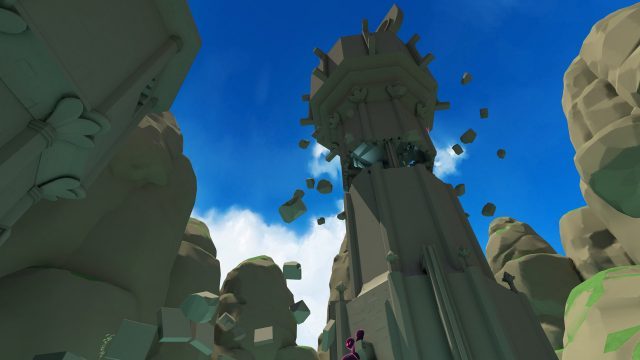Cloudborn is an indie first-person VR exploration game, currently available on Steam Early Access, where the player is tasked with ‘cleansing the corruption’ by traversing the world to reach ‘cores’ using an intuitive climbing mechanic. Unfortunately, the “melancholic journey of discovery and serenity” is sometimes rudely interrupted by the temperamental movement system.
Upon starting the game, you are presented with a menu console to apply or adjust the comfort settings—it’s an odd-looking 3D menu with unnecessary physics on the switches, making them difficult to operate, but it’s not something you’ll need to access often. Gameplay involves constant walking, running and climbing in first-person—freeform locomotion that is a common cause of VR sickness if not designed carefully. According to lead designer Alberto Amigo, the game’s conception was a result of wanting to improve VR movement systems, so maintaining player comfort through unique movement schemes is a priority.
Rather than just walking by pressing a stick or button, by default forward movement is generated by swinging your arms in a walking or jogging motion. As virtual movement is tied to the speed of the arm swings, it connects your body to the action in a more natural way, reducing the chances of nausea compared to controlling movement with a joystick. This can be disabled, and you can employ traditional artificial locomotion with a Vive controller touchpad or Oculus Touch thumbstick. As arm movement is central to the climbing mechanics, the game is not only more comfortable, but far more enjoyable and immersive when you swing your arms to run.
For those with front-facing tracking setups, snap-turning (plus an instant 180 input option) is a more comfortable way of rotating your view, and peripheral vision will reduce as you turn, fading to black—another effective way of mitigating a common nausea trigger. Unfortunately the snap turning has a slight acceleration which can still cause discomfort for those particularly sensitive (there should be an instant snap option). This can all be disabled, and you can turn smoothly with your thumb, or simply turn your body if you have a 360-degree tracking setup. There is also an option to enable visual references like a floor grid or a transparent ‘cage’ around you, but these seem to have technical issues at the moment.

Climbing is intuitive. Almost any top edge of a surface can be grabbed, as well as conveniently-positioned vines growing through the ruins. The triggers represent your grip, and you climb freely by alternating grabs between your hands. A heartbeat sound indicates your stamina limit, which is recovered by holding on with both hands. It’s also possible to give yourself momentum to clear a big gap by releasing your grip just at the right moment as you push away from a hand-hold. This is described as a “unique momentum-system”, but a very similar mechanic has appeared in several other VR titles already, with Climbey (2016) being the most obvious example.
When it works, Cloudborn’s movement, particularly the climbing, is very enjoyable. Unfortunately, it suffers from regular glitches, and frustrating alignment problems. When climbing along a ledge, the camera will align itself perpendicular to the wall, which makes sense. Grab a vine that’s near a wall, and it’ll likely do the same. But if you grab a free-hanging vine, the camera will attempt to pick a logical direction to face, often getting it wrong and you end up clipping through other objects, resulting in a black screen. Raising yourself up to the top of ledges and objects is also far more awkward than it needs to be. The required input is to swing both arms down and behind your back, quite fast otherwise it won’t register. Sometimes, this movement flings your body 50ft into the air, ending in your death. A similar mechanic is far more intuitive and simple to execute in Climbey, and so we expect that through the game’s Early Access period the mechanics will be refined to be more reliable.

The same can be said for momentum swinging: pushing yourself off something to clear a gap is extremely unreliable, to the point where it feels almost random. Sometimes I’ll get no momentum at all, and other times, when I simply want to release my grip and drop down gently, it’ll generate a huge lateral movement, flinging me to another untimely death. Again, no such problems in Climbey.

Despite the movement frustrations, Cloudborn manages to deliver an intriguing, atmospheric experience. It is short on content at the moment, with just six environments to navigate through. Traversal difficulty increases at a reasonable rate, but there isn’t anything to do beyond reaching each ‘core’. The design of the ruins hint at a lost civilisation, and you can also spot strange movements coming from the land itself, as if the whole environment is riding on the back of giant creature of some kind. Currently, this remains unexplained in the Early Access version, so hopefully the team have plenty of ideas to flesh-out a story.
According to their recent blog entry, Logtown Studios plan to increase interactivity very soon, improve the visuals and add new levels, as well as addressing technical problems. Cloudborn is worth keeping an eye on; it has the potential to become an absorbing VR experience, and a welcome change of pace from many first-person action games.






